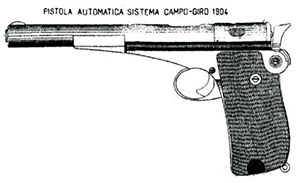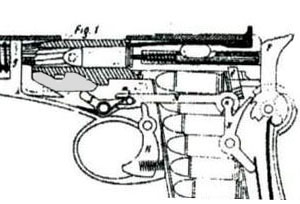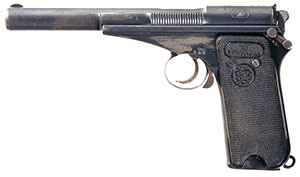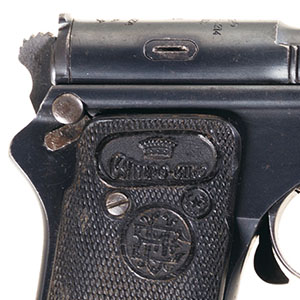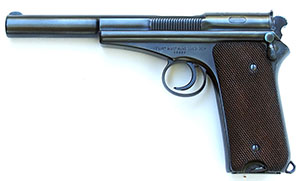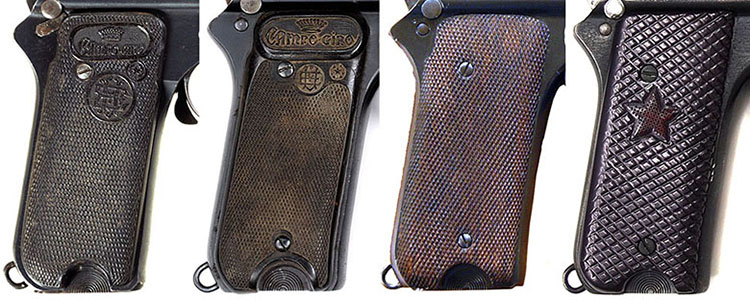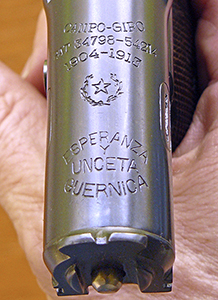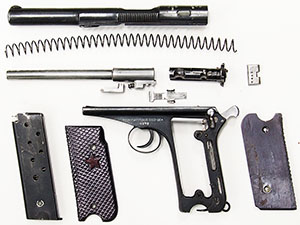 |
|||||||||||||||||||||||||||||||||||||||||||||||||||||||||||||||||||||||||||||||||||||||||||||||||||||||||||||||||||||||||||||||||||||||||||||||||||||||||||||||||||
|
The Campo-Giro Pistol by Ed Buffaloe At present the primary English-language source for information on the Campo-Giro pistol is Leonardo M. Antaris’ book Astra Firearms and Selected Competitors. I have tried to supplement his information with other sources whenever possible. Historical Background Don Venancio López de Ceballos y Aguirre, third Count of Campo-Giro and a retired lieutenant colonel in the Spanish army, was a member of the Comisión de Experiencias de Artillería that was formed in 1896 to select an automatic pistol for use by the Spanish military. The commission evaluated most of the major automatic pistols of the day and eventually chose the Model 1903 Bergmann Mars pistol. However, Bergmann did not have a factory of his own and the Spanish order of 3000 pistols would have provided insufficient capital for him to tool up for full production without additional orders, so in 1907 he licensed Henri Pieper of Liege, Belgium to manufacture the pistol which subsequently became known as the Bergmann-Bayard. Bayard (the name of a legendary horse and, by association, the knight who rode him) was a trade name used by Pieper. According to Antaris, the Bergmann Bayard was never formally adopted by the Spanish, but the 3000 pistols (which were finally delivered in 1910) did see service in the Spanish Military. The
As a military man, Don López had a long-standing interest in weaponry. According to Antaris: “He had started to design a semiautomatic pistol in about 1900 and had functioning prototypes built in the Fábrica De Armas Portátiles of Oviedo by 1903. His smaller caliber pistols were blowbacks while the larger guns, patented with a locked breech design, had a sliding wedge to buffer the frame impact upon recoil.” He patented his original design on 7 October 1904 (Spanish patent number 34798). Subsequent patents were refinements of the first, with some of the modifications having been requested by the military. López received patent number 49270 in 1910 and 54214 in 1912. Unfortunately, I have been unable to examine these patents and so cannot give details about the designs, but a few facts emerge from various sources.
López provided the military with four 9mm prototypes in 1909 and, after the Small Arms Commission requested some changes, he provided another 25 sometime in 1912. The 1912 gun is now referred to as the M1912. Like the earlier guns, it was manufactured at the Fábrica De Armas Portátiles (small arms factory) in Oviedo. The M1912 was accepted for military use by the commission, and subsequently by royal order of the King on 24 September 1912, but López had already begun redesigning the gun again. The Model 1913 López was awarded Spanish patent 55916 on 4 July 1913. An unlocked breech design with a recoil buffer spring beneath the barrel did not have any more recoil than a locked breech design and was much cheaper and simpler to manufacture. Apparently, it was also more accurate than the design with the reciprocating barrel, and after further testing the commission eventually approved the new design as the Model 1913, though it is more often referred to as the Campo-Giro, the name stamped on top of the slide and on the early grips. (Masa states that López’s locked breech design was based on one of Ferdinand Mannlicher’s patents. I have not been able to match López’s design with any of Mannlicher’s, but Mannlicher’s 1899 Austrian patent number 49776 has a recoil buffer spring beneath the barrel, much like the Model 1913.)
The unlocked breech design of the Campo-Giro was quite unusual in a gun chambered for a powerful military cartridge. The Model 1913 retains an external hammer and a top ejection port like the Bergmann -Bayard, but has its magazine in the grip instead of in front of the trigger guard, allowing for a much longer barrel that produces a greater muzzle velocity from the 9mm Largo round than the Bergmann-Bayard. The slide locks open when the last round is fired. The recoil buffer cushions the slide at the end of its recoil. A distinguishing feature of the Model 1913 is the magazine release behind the trigger guard. The magazine has its baseplate extending toward the rear, a vertical slot in the back for viewing cartridges, and a cut in the rounded forward edge near the top to engage the magazine release. Early magazines for the military are numbered to match the gun. A single hole is drilled through both sides for holding the spring during assembly. On later magazines, the left side is stamped with a star in a wreath. The magazine follower is stepped to engage the slide hold-open mechanism. The magazine holds 8 cartridges. The lower portion of the grip frame has two half-moon cutouts to allow the bottom of the magazine to be grasped by the fingers on either side. The magazine itself has semi-circular serrations where the fingers grasp it. The lockwork is relatively simple. A Browning-style stirrup-shaped connector runs on either side of the magazine from the trigger back to the sear, providing a smooth, even trigger pull. A single U-shaped spring at the rear of the grip tensions both the hammer and the sear. The disconnector is unusual. There is a cradle beneath the barrel in which rests the recoil buffer block. This cradle is the actual disconnector. Two tabs extend upward from this cradle on either side of the buffer block, and the lower portion of the cradle rests on a forward extension of the connector bar. As the slide comes back, a raised portion of metal at the forward end of the slide depresses the two tabs, and the cradle depresses the forward end of the connector, disconnecting it from the trigger. It remains disconnected until the slide returns to battery and the trigger is released.
The breech block is fixed in the slide and held on the frame by a crossbolt which in turn is held in place by the firing pin. The forward edge of the grip frame is stepped and narrows slightly just behind the trigger guard. There are 21 triangular-cut slide serrations centered beneath the ejection port, starting about 2¼ inches forward of the rear edge of the slide. The grip plates are of checkered buffalo horn with an oval cartouche at the top featuring a crown and the words ‘Campo -Giro.’ Beneath the cartouche on one side is the single grip screw and on the other side is a star in a wreath. Beneath this is an ‘EYU’ monogram in a circle (for Esperanza y Unceta). Instead of a second grip screw, the lower portion of the grip plate has a dovetail slot that fits over a tab at the bottom of the grip frame. The grip plates are numbered to match the gun. The slide inscription is on the top, toward the rear, and reads as follows in all capital letters: CAMPO-GIRO Early guns have a crown at the top of the inscription, and all guns have a star in a wreath between the dates and the maker’s name. The guns are also marked on the left side of the frame: «Pista. auta. mod. 1913» The serial number is beneath the left side inscription, just above the trigger. Serial numbers run from 1 to 1367. According to Antaris, the military received 960 of the Model 1913, and 407 were sold commercially, making a total production of 1367. The military guns were issued with a manual and holster, including a cleaning rod and (I assume) a spare magazine. The Model 1913-16 Production of the Model 1913 was suspended for much of 1915 and 1916 while Esperanza y Unceta made ‘Ruby’ or ‘Eibar-type’ pistols for sale to the French during World War I. In the interim López made some final design changes to the gun, which he patented as an addendum to his earlier patent, resulting in the Model 1913-16.
Moving the magazine release required a redesign of the magazine. The cut on the front rounded surface was eliminated, as was the slot for viewing cartridges at the rear. Instead, seven holes are drilled through both sides for viewing cartridges and assembling the magazine. There is a horizontal slot at the rear about an inch up from the bottom to engage the magazine release. Hence, magazines are not interchangeable between the two models. There may be some minor changes to lockwork or other internal parts, but I am unable to verify or describe them at the time of this writing.
Grip plates on the Model 1913-16 are held in place by two screws, and the tab at the bottom of the frame on the M1913 is eliminated on the M1913-16. The early grip plates are of checkered buffalo horn and feature markings similar to those on the Model 1913, with the oval cartouche slightly larger and the round monogram slightly smaller. During WWI the supply of buffalo horn was unreliable, so plain checkered wooden grips were often installed. Later if the buffalo horn grips became cracked or broken, wooden grip plates were usually substituted. During the Spanish revolution some of these guns were fitted with aluminum grip plates with incised cross-hatched lines and a stippled red five-pointed star beneath the upper grip screw.
CAMPO-GIRO There is a star in a wreath between the dates and the maker’s name. The guns are also marked on the left side of the frame: «Pista. auta. mod. 1913-16» The serial number is beneath the left side inscription, just above the trigger. Serial numbers run from 1 to 13725. Antaris indicates that approximately 13,157 were sold to the military and 536 were sold commercially. Both models continued in use through the Spanish civil war, and some possibly later. According to Antaris, some of the Model 1913-16 guns were later acquired from the military by the Astra company and “were engraved, silver plated, fitted with pearlite grips, cased and used as part of Astra’s trade show display.” The remaining arsenal guns were eventually sold to Samuel Cummings and resold by his company Interarms, which is how the majority of these guns came into the U.S. The Campo-Giro was the direct forerunner of the Astra tubular slide pistols.
The Campo-Giro is well made and reasonably accurate, if a bit heavy, though the weight helps to absorb recoil. The slide serrations are not optimally placed in my opinion, the grip angle is not quite right, and the recoil spring is so powerful that the slide can be difficult to retract. The biggest complaint about the gun is that it is difficult to disassemble and reassemble--it can be accomplished by one person with considerable manual strength but it is much easier with two. I was able to disassemble mine without assistance, but I had to have help to compress the recoil spring when I reassembled it. I would recommend that most people simply lock the slide open to clean the barrel. At the range, I found that I could keep all shots on a paper plate at 10 yards, but I could not get a small group with the Campo-Giro. Recoil was manageable, even with hot modern ammunition, but I had repeated failures to eject which can probably be attributed to a 100 year old magazine spring. Antaris has an interesting paragraph wherein he explains that Spain standardized the 9mm Largo cartridge with a lesser charge of powder than the 9mm Bergmann cartridge, using .40 grams of powder rather than the .48 grams used by the Bergmann. White and Munhall, in their book Pistol and Revolver Cartridges, list the DWM 9mm Bergmann-Bayard cartridge as producing a muzzle velocity of 1116 feet/second. This would have produced 347 foot-pounds of energy with a 125 grain bullet. I tested some Spanish 9mm Largo ammunition made in Seville in 1962 in the Campo-Giro pistol--this ammunition has a 128 grain bullet with 10.5 grains of powder (.68 grams) that produced an average muzzle velocity of 905 feet/second and a muzzle energy of 233 foot-pounds. I also tested modern CCI Blazer 9mm Largo ammunition with a 124 grain bullet, which produced an average muzzle velocity of 1226 feet/second, giving a muzzle energy of 416 foot-pounds. The Spanish-made 9mm Largo ammunition is actually slightly less powerful than most modern standard velocity 9mm Parabellum ammunition, but the CCI Blazer ammo is approximately equivalent to modern 9mm Parabellum +P ammo. Disassembly
Further disassembly should not be attempted. Reassembly is in reverse order. The recoil buffer spring must be compressed by pushing the spring against its seating point in the recoil buffer block and the two lugs on the bottom of the barrel inserted into the slots in the frame. Lay the bolt flat-side-down with the rear notch over the cocked hammer. Run the slide up onto the bolt against the resistance of the recoil spring and rotate the bolt so the sight is upright. Depress the firing pin spring and reinstall the crossbolt from left to right, with the slot on the right side of the gun. J.B. Wood says: “Field stripping should not be attempted by those not familiar with automatic pistols...”
|
|||||||||||||||||||||||||||||||||||||||||||||||||||||||||||||||||||||||||||||||||||||||||||||||||||||||||||||||||||||||||||||||||||||||||||||||||||||||||||||||||||
|
|||||||||||||||||||||||||||||||||||||||||||||||||||||||||||||||||||||||||||||||||||||||||||||||||||||||||||||||||||||||||||||||||||||||||||||||||||||||||||||||||||
|
|
|||||||||||||||||||||||||||||||||||||||||||||||||||||||||||||||||||||||||||||||||||||||||||||||||||||||||||||||||||||||||||||||||||||||||||||||||||||||||||||||||||
|
|
|||||||||||||||||||||||||||||||||||||||||||||||||||||||||||||||||||||||||||||||||||||||||||||||||||||||||||||||||||||||||||||||||||||||||||||||||||||||||||||||||||
